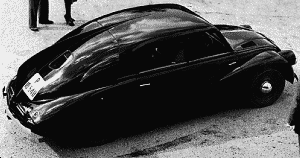

The streamlining era at Tatra was foreshadowed in October, 1933 by a special prototype displayed by the British Tatra consessionaire, one D. Fitzmaurice, at the Olympia Motor Show in London, England. It was called the Tatra-Fitzmaurice and had a streamlined body designed by D. Fitzmaurice and made by Thomas Harrington Ltd. (of England) mounted on a special Tatra-supplied chassis with a front-mounted 1.48-litre air-cooled 4-cylinder engine (a modified T75 unit). It was offered for sale at a very high price and no copies were built.
 Tatra-Fritzmaurice
Tatra-FritzmauriceNineteen-thirty-three also marked the beginning of the era of Tatra automobiles with rear-mounted (directly behind the rear axle) engines, a requirement for the truly aerodynamically efficient automobile - at least as established scientifically by the Hungarian streamlining specialist Paul Jaray. As well this engine placement had an effect of reducing engine noise (air cooled units do tend to get noisy) inside the vehicle and allowed the front of a car to be as short as possible while prompting a long tail, both of which were aids in reducing aerodynamic drag. Of course one disadvantage of placing the engine in the rear is that it creates difficulty in attaining good weight distribution. The somewhat related concept of positioning the engine in front of the rear axle (so-called "mid engine" layout) would be better in this regard but very impractical for a multiple-passenger luxury automobile. And as a side note, having the engine and driving wheels on the same end has advantages, such as weight reduction, less efficiency loss in the drive, no vibrations caused by a long drive shaft, and a flat floor.
The importance of streamlining in automobiles cannot be overlooked. Aerodynamic efficiency has numerous advantages, some of the more significant are reduced fuel constumption, increased stability, possibility of higher speeds, and greater safety. In addition, it obviously creates an opportunity for interesting styling ideas.
Since about 1930 the Tatra design team, headed by Hans Ledwinka and
composed notably of Erich Uberlacker and a few other engineers, had been
considering the concept of mounting an air-cooled engine at the posterior end
of a back-bone chassis.
 (C.W.)
(C.W.)In 1931 an experimental prototype rear-engined Tatra was constructed with a conventional body which looked to be made up of standard components. It must have been successful as indicated by another prototype developed in 1933, the V570. This was a very advanced study-vehicle with an aerodynamic body of steel sheets covering a wooden structure and capable of seating 4 persons. A 854cc horizontaly-opposed 2-cylinder air-cooled engine drove the rear wheels.
T77 with optional canvas
roof
 The 5th of March, 1934, is certainly a date to remember. On that day took
place the official introduction of the Tatra 77, having the honor of being
the world's first serially produced aerodynamically styled automobile powered
by an air-cooled rear-mounted engine. This massive and roomy, seating for six
provided, luxury car had an exceptionally low coefficient of drag. The
occupants sat low and comfortably between the axles of this V8-powered and
astonishingly low 4-door automobile. With the steering wheel situated
centrally at front, the driver must have had quite a view out the 45-degree
slanted windshield. There was lots of luggage space, above the rear
suspension and in the nose, where the spare tires and battery resided. The
efficiently streamlined body, complete with stabilizing dorsal fin, was mounted on a
central tube chassis welded to a box-type frame which forked at back to
surround the motor. Unfortunately the placement of the engine so far back did
cause weight-distribution problems coupled with the swing-axle suspension
which greatly affected handling, something that required quite a bit of
getting used to. Nonetheless, the T77 was still a remarkable achivement
considering, among other things, that its relatively small 2.97-litre
power-plant propelled it to a top speed of over 140 km/h. The then chief
engineer Erich Uberlacker was mainly responsible for the design and actually
suggested the use of aerodynamic bodywork, for the construction of which a
license from the Budd Manufacturing Co. of USA (where incidentaly Hans
Ledwinka's relative Joseph Ledwinka worked) was obtained.
The 5th of March, 1934, is certainly a date to remember. On that day took
place the official introduction of the Tatra 77, having the honor of being
the world's first serially produced aerodynamically styled automobile powered
by an air-cooled rear-mounted engine. This massive and roomy, seating for six
provided, luxury car had an exceptionally low coefficient of drag. The
occupants sat low and comfortably between the axles of this V8-powered and
astonishingly low 4-door automobile. With the steering wheel situated
centrally at front, the driver must have had quite a view out the 45-degree
slanted windshield. There was lots of luggage space, above the rear
suspension and in the nose, where the spare tires and battery resided. The
efficiently streamlined body, complete with stabilizing dorsal fin, was mounted on a
central tube chassis welded to a box-type frame which forked at back to
surround the motor. Unfortunately the placement of the engine so far back did
cause weight-distribution problems coupled with the swing-axle suspension
which greatly affected handling, something that required quite a bit of
getting used to. Nonetheless, the T77 was still a remarkable achivement
considering, among other things, that its relatively small 2.97-litre
power-plant propelled it to a top speed of over 140 km/h. The then chief
engineer Erich Uberlacker was mainly responsible for the design and actually
suggested the use of aerodynamic bodywork, for the construction of which a
license from the Budd Manufacturing Co. of USA (where incidentaly Hans
Ledwinka's relative Joseph Ledwinka worked) was obtained.
In 1935 followed the improved Tatra 77a. An extra central headlight was added and could optionally be made to turn with the steering wheel (more precisely, three different directions of the headlight were possible), that must have been quite the experience for night drivers! Increasing the capacity of the V8 to 3.4-litres raised output to 75 bhp and maximum speed to 150 km/h. Driving characteristics were also improved and the styling (aesthetically speaking) was cleaned-up slightly. Aerodynamics were still awesome with the drag coefficient of 0.21 (the cd of the original 77 is not exactly known but presumably is very similar).
 T77A
T77A

The production of both the T77 and T77a was very limited, numbering 105 of the former and no more than 150 of the latter. It is also important to note that, since both models (like most Tatra models) were hand built, no two were exactly alike.
Nineteen-thirty-six (1936) brought the company yet another name change.
Baron Hans von Ringhoffer, the proprietor of the Tatra works since 1923,
decided to combine Tatra with his Prague-Smichov wagon factory to create the
Ringhoffer-Tatra concern.

The remarkable T87, which happend to be Hans Ledwinka's favourite Tatra, also bowed in
1936 as a direct response to the critics of the previous model's
unexceptional handling abilities. The weight was substantially reduced to
1370 kg (a saving of over 400 kg), accomplished by mounting a smaller
2.97-litre 75 bhp V8 made of alloy and by decreasing the length of the car
(the wheelbase went from 3150 to 2850 mm). This greatly helped improve the
weight distribution to 38% at front and 62% at rear which had a substantial
effect on performance and driving characteristics. The drag coefficient of
the T87, due to the shortened but still spacious body, did suffer but, at
0.36, was still exceptional in its day and even now would not be considered
unexceptable. The rigid and double-walled body was now of monocoque
(uni-body) construction and was especially strong in the passenger
compartment, making it safer. And the windshield was flanked by small windows
inserted at the A-pillars giving the driver, now positioned in the
conventional fashion, exceptional visibility.
 (T.a.)
(T.a.)The Tatra 87 attained at top speed of about 160 km/h and had good acceleration. Engine noise remained very low in the interior and the ride was pretty smooth even at higher speeds. And fuel economy was very good for a car of this class, at an average 12/13 litres per 100 km.
 rear view of unrestored T87 at the Schlumpf collection
rear view of unrestored T87 at the Schlumpf collectionEven though the Tatra T87 was a rather expensive luxury automobile, the company managed to sell 3056 copies of it until about 1950.
Later during the year Erich Ledwinka, one of Hans' sons, replaced Mr. Uberlacker (who left due to a disagreement with management) as chief engineer. He would be responsible for the last pre-war Tatra automobile, the short-lived T97 which came out in about 1936/37.
The T97 looked very much like a
scaled-down T87 except for the missing central headlight, a flat one-piece
windshield, and a rear glass split window instead of the 'venetian blinds' which
must have improved rearward visibility substantially. Otherwise its design
and construction was essentially like that of the concurrently produced T87
and propulsion came from a 40 bhp 1.75-litre 4-cylinder unit which allowed a
very respectable 130 km/h. And it was quite roomy inside despite the shorter
length (and a wheelbase reduced by 250 mm to 2600 mm).


In 1938 Tatra fell under German control due to the annexation of part of Czechoslovakia by the Germans. This meant halting all production and having all patents confiscated.
World War II broke out in 1939 and Tatra was forced to produce military vehicles. The T87, referred to as "the Autobahn car" by the general inspector of Germany's Autobahn network, was also allowed into limited production (for civilian use) along with some other automobiles. Strictly forbidden, however, was the manufacture of the T57 (which had been very popular) and especially the T97 "people's cars", certainly due to their closeness to Porsche's Volkswagen design. Therefore the life of the T97 with a great potential for success as a family car was terminated after only 508 copies were produced.